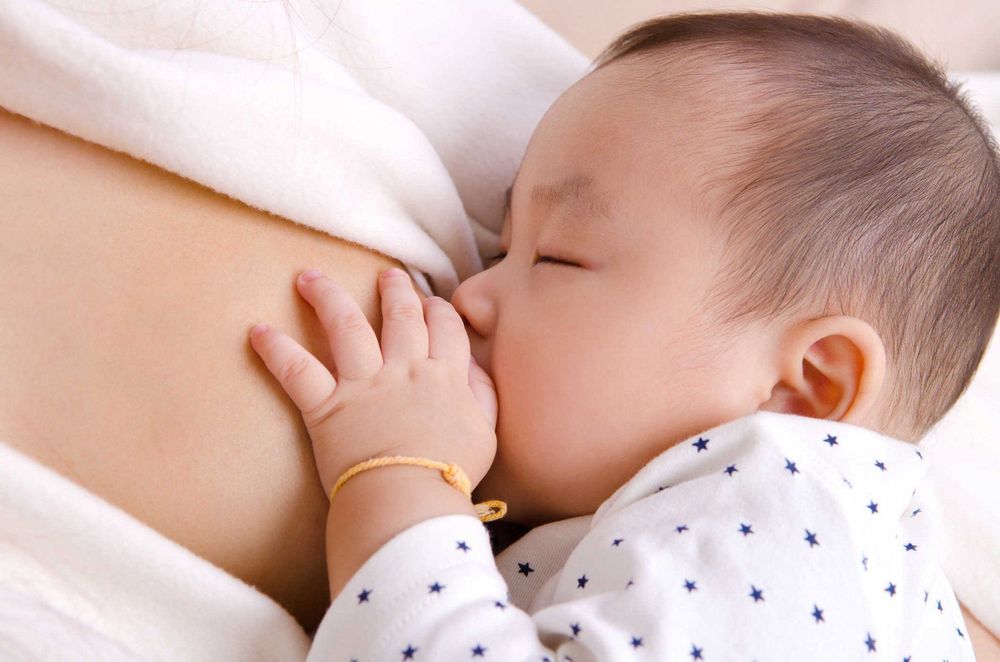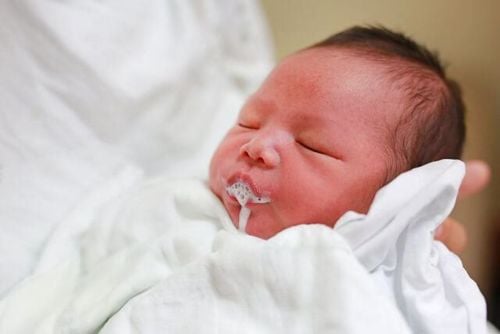This is an automatically translated article.
The article was professionally consulted with Specialist Doctor I Dang Thi Ngoc Chuong - Pediatrician - Pediatrics - Neonatal Department, Vinmec Central Park International General Hospital.Vomiting, if going on for a long time, will make the child anorexic, leading to a lack of nutrients, affecting the child's development. Therefore, vomiting should not be underestimated.
1. Causes of children vomiting with phlegm
Because the baby's digestive system is not yet complete, it is easy for the baby to swallow gas when suckling, this amount of gas is the cause of the baby's regurgitation. If the spitting up occurs only in the first few months and the baby is healthy, there is no cause for concern. However, if vomiting occurs with sputum, accompanied by wheezing, it is likely that the child is suffering from acid reflux or an allergy. Acid reflux can cause increased secretion of viscous sputum leading to vomiting milk and wheezing. Atopic allergies cause increased secretion and stagnation of viscous sputum in the roof of the nose, causing stuffy nose, so children have to breathe through their mouth.Having phlegm in the throat due to breathing problems makes it difficult for children to breathe and cough and the throat is easily irritated, so when spitting up milk, there is also phlegm.
Other causes that cause babies to vomit or vomit may also be infected with a virus that causes high fever, runny nose, and cough. Children usually present with diarrhea within the first 1-2 days followed by vomiting for 12-72 hours.

2. How to prevent vomiting in children
Children need to be rinsed with physiological saline 3-5 times a day and monitor the progress of the disease. If there is no improvement, the child should be taken to a medical facility for a more thorough examination.Pay attention to the position of the baby when feeding to reduce vomiting. When suckling, the baby should be tilted about 35-45 degrees, let the baby suck the left breast first and then switch to the right breast.
When sleeping, it is necessary for the child to lie on his or her side, with the pillow higher than 2 shoulders and note to change the sleeping position for the baby.
Do not let the baby lie down immediately after feeding but should hold the baby on the shoulder and stroke the back until the baby burps.
Trắc nghiệm: Sự phát triển tinh thần, vận động của bé thế nào là đúng chuẩn?
Khi nào bé biết nói, biết hóng chuyện hay biết cầm cốc là "đúng chuẩn"? Điểm xem bạn biết được bao nhiêu mốc phát triển tinh thần, vận động "đúng chuẩn" của bé nhé!The following content is prepared under supervision of Thạc sĩ, Bác sĩ y khoa, Ma Văn Thấm , Nhi , Phòng khám Đa khoa Quốc tế Vinmec Dương Đông(Phú Quốc)
3. How to handle babies who spit up milk with phlegm
If the child has a fever, cough with phlegm, and a runny nose, the child should be taken to a medical facility for examination. In addition, the following methods can be performed at home to make the child feel more comfortable.Back patting: Regularly patting the back of the child will help the lungs circulate blood better and the phlegm in the throat is easier to be pushed out. When performing back patting, let the child lie on his or her side without a pillow. Use a soft towel under the child's bottom to form an angle of 15 degrees. Then, pat your baby's back repeatedly from the lungs toward the neck. When clapping, it should be handled gently to avoid causing pain to the child. Perform continuous patting for 3 minutes then stop. For young children, after patting, you must hold the child in your arms in a safe position and cause a cough for the child by gently rubbing your finger on the child's neck so that the child coughs and spits out. Feed your baby many times and feed the baby properly: When a child spits up milk with sputum, the baby should be fed several times, each feeding about 2 hours apart to avoid the baby being too full. Do not shake or move while the baby is nursing.

In Vietnam today, 7 out of 10 children under 5 years old have zinc deficiency and 8 pregnant women have zinc deficiency. The prevalence of zinc deficiency in pregnant women is 80.3%, women of childbearing age 63.6% and children under 5 years old is 69.4%. The most common manifestations of zinc deficiency in children are growth retardation, mild and moderate malnutrition, delayed growth in height, and some observable symptoms such as anorexia or decreased appetite, decreased suckling, and no meat. fish, slow digestion, mild constipation, persistent nausea and vomiting in children. In addition to reasonable zinc supplementation, parents also need to provide their children with other important vitamins and minerals such as lysine, chromium, B vitamins,... resistance to minor illnesses and less digestive problems.
Please visit the website vimec.com regularly and update useful information to take care of your baby and family.















